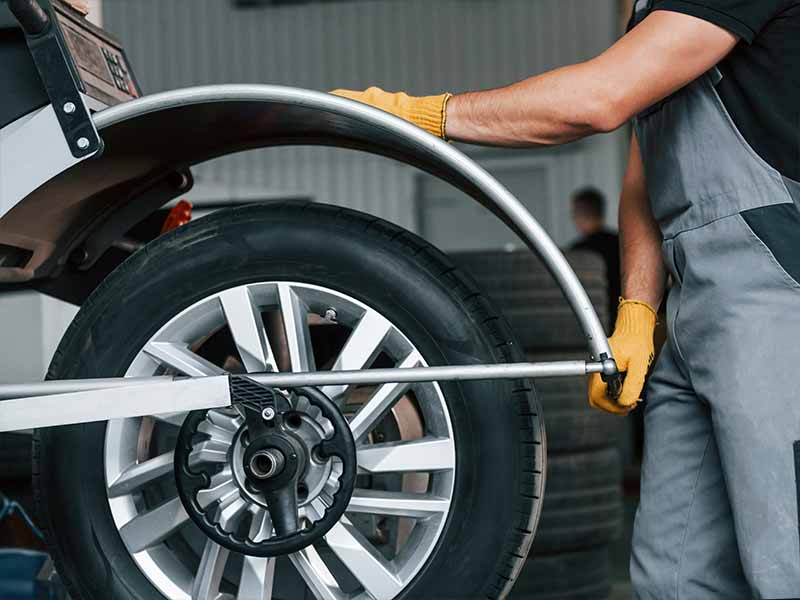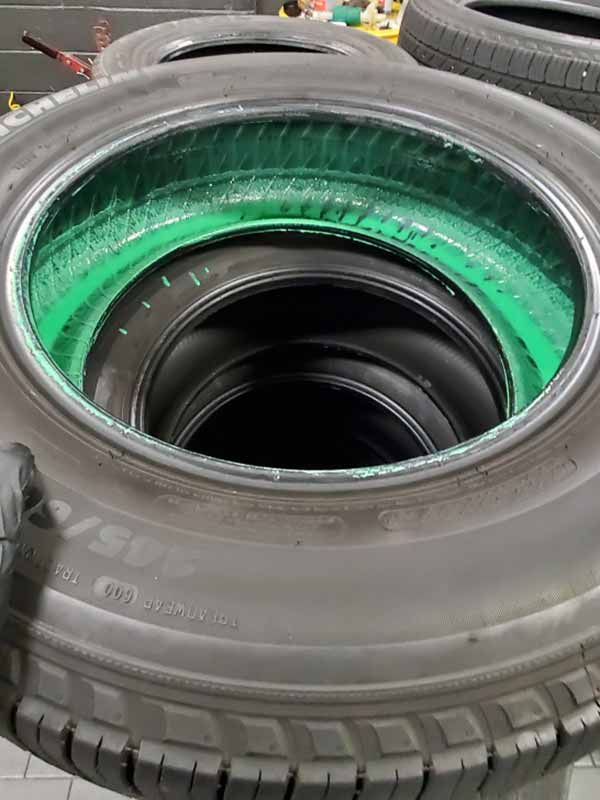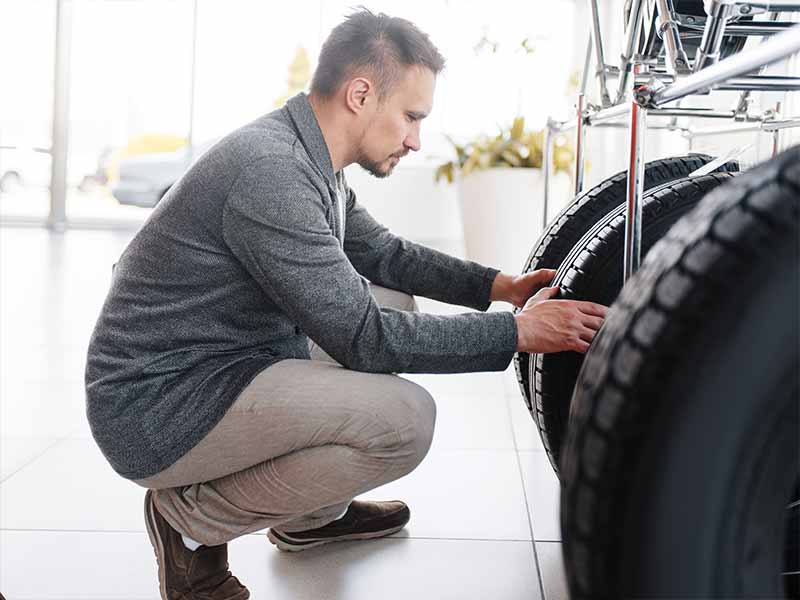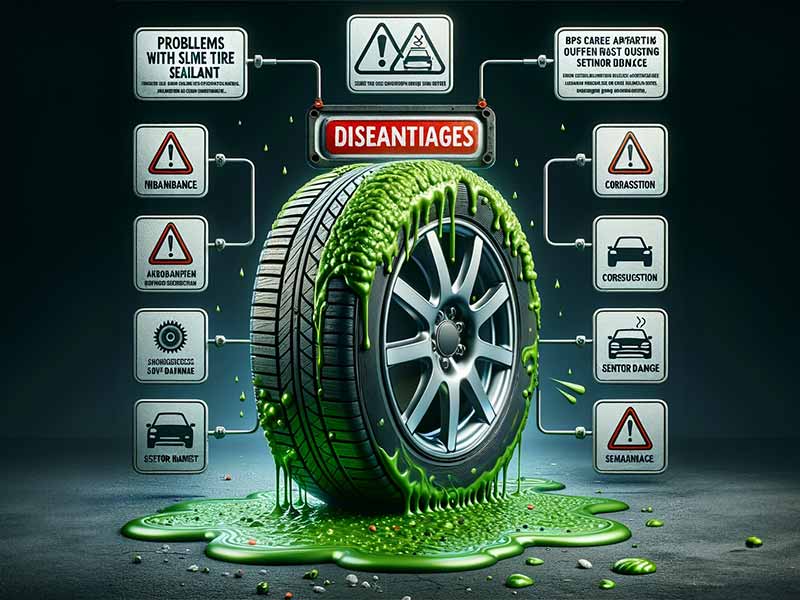You’re cruising along the highway, and suddenly, your tire pressure light flickers on. You remember that bottle of Slime Tire Sealant in your trunk, touted as the go-to emergency fix. But is it really the tire lifesaver it claims to be?
Problems With Slime Tire Sealant
Slime Tire Sealant can provide a temporary fix for small tire punctures, but it often leads to wheel imbalance, potential damage to tire pressure sensors, and can complicate future tire repairs.
In this article, we delve into the often overlooked disadvantages of using Slime Tire Sealant, examining its impacts from a practical, environmental, and financial perspective.

Limited Effectiveness
When it comes to getting back on the road quickly after a puncture, Slime Tire Sealant seems like a nifty solution. But hold on, it’s not the tire-saving superhero it’s often made out to be. Let’s dive into why its effectiveness might not be as great as you think.
Temporary Solution
- Quick Fix, Not a Cure: Think of Slime as a band-aid. It’s great for a quick patch-up, but it’s not going to heal the wound. In tire terms, this means it can get you rolling again, but it’s not a permanent fix for tire punctures.
- Short Lifespan: The sealing effect of Slime doesn’t last forever. Over time, its efficacy reduces, which means you’re only buying time until a proper repair.
Ineffectiveness on Large Punctures
- Size Matters: Slime works fine for small punctures, typically those up to ¼ inch. But when it comes to larger gashes or cuts, it struggles. If you’ve got a sizeable puncture, Slime is more likely to wave a white flag than fix the problem.
- Type of Damage: It’s not just size; the type of puncture also plays a role. Slime is less effective on punctures on the sidewall of the tire, which, unfortunately, are not that uncommon.

Impact on Tire Balance
Now, let’s roll into another key issue with Slime Tire Sealant – its impact on tire balance. It’s a bit like adding an uneven weight inside your tire, and as you can guess, this doesn’t bode well for a smooth ride.
Imbalance Issues
- Uneven Weight Distribution: When you inject Slime into your tire, it doesn’t always spread evenly. This can lead to parts of your tire being heavier than others, which causes imbalance.
- Vibrations and Wear: An unbalanced tire can lead to vibrations in your steering wheel, seat, or floorboard. More than just an annoying shake, this imbalance can also cause uneven tire wear, leading to a shorter tire lifespan and potentially unsafe driving conditions.

Difficulty in Tire Repair and Replacement
Alright, let’s tread into another sticky aspect of using Slime Tire Sealant – the complications it introduces when you need to repair or replace your tire. It’s a bit like using a strong adhesive for a quick fix; it holds for a while but makes future repairs tougher.
Complications in Professional Repair
- Messy Business: Ask any tire technician about Slime, and you might see them cringe. The sealant turns into a sticky, gooey mess inside the tire, making the repair process more labor-intensive.
- Extra Cleaning Required: Before a tire can be properly repaired or patched, all the Slime must be removed. This extra step means more time and effort, which often translates to higher repair costs for you.
Issues During Tire Replacement
- Difficulty in Mounting New Tires: The remnants of Slime on the wheel can make mounting a new tire challenging. It’s crucial to thoroughly clean the wheel to ensure the new tire fits and seals correctly.
- Potential for Improper Sealing: If any residue is left behind, it can prevent the new tire from sealing properly on the wheel. This can lead to air leaks and, ironically, the very issue Slime is supposed to prevent.

Cost and Value Considerations
Finally, let’s roll into the financial aspect of using Slime Tire Sealant. It’s crucial to weigh the cost against the value, just like considering whether a cheap fix now might lead to expensive problems later.
Short-term vs Long-term Costs
- Immediate Savings vs Future Expenses: Sure, Slime offers a low-cost, immediate solution. But consider the potential future costs – tire imbalances leading to early replacements, corrosion issues, and complications in professional repairs.
- Hidden Costs: These future expenses can quickly add up, making the initial savings less appealing. It’s a classic case of “penny wise, pound foolish.”
Alternative Solutions
- Investing in Quality Repairs: Instead of relying on temporary fixes, investing in quality tire repairs or replacements often proves more cost-effective in the long run.
- Preventive Measures: Regular tire maintenance, such as proper inflation, rotation, and alignment, can reduce the likelihood of punctures and other issues, making the need for emergency solutions like Slime less likely.

Corrosion and Damage to Wheels
Revisiting the topic of Slime Tire Sealant and its effects on wheels, it’s important to note the specific formulas designed to be safe for use with tire pressure monitoring systems (TPMS). According to Slime’s website:
- TPMS Safe Formulas: The yellow label Emergency Tire Sealant for highway vehicles and the blue label Prevent and Repair Tire Sealant for non-highway tubeless tires are both TPMS safe. Look for the Tire Sensor Safe icon on these bottles.
- Formulas to Avoid with TPMS: The red label Prevent and Repair Sealant for Tubes and the 2-in-1 Tire & Tube Premium Sealant are not safe for TPMS.
Furthermore, Slime advises against using their tire sealant in tires with pre-existing damage and recommends not leaving the sealant inside tires for more than two years. After this period, the integrity of the rims cannot be guaranteed. The Emergency Tire Sealant is intended as a temporary emergency repair in passenger vehicles, emphasizing the importance of timely professional tire maintenance after its use.
Resources
Below are some links you may find helpful when learning about tires:
- Why tire sealant may not be the solution – Christian Science Monitor
- 5 tire sealant myths busted – Slime
Final Thoughts
While Slime Tire Sealant offers a quick and convenient solution for minor tire punctures, its disadvantages are significant and wide-ranging.
From potentially causing wheel imbalance and corroding wheels to complicating future tire repairs and posing environmental risks, Slime is not the all-in-one solution it’s often thought to be.
It’s crucial to weigh these factors against the immediate convenience Slime provides. Remember, a thorough and professional tire check or repair is often the safer and more cost-effective route in the long run.
Good luck and happy motoring.





